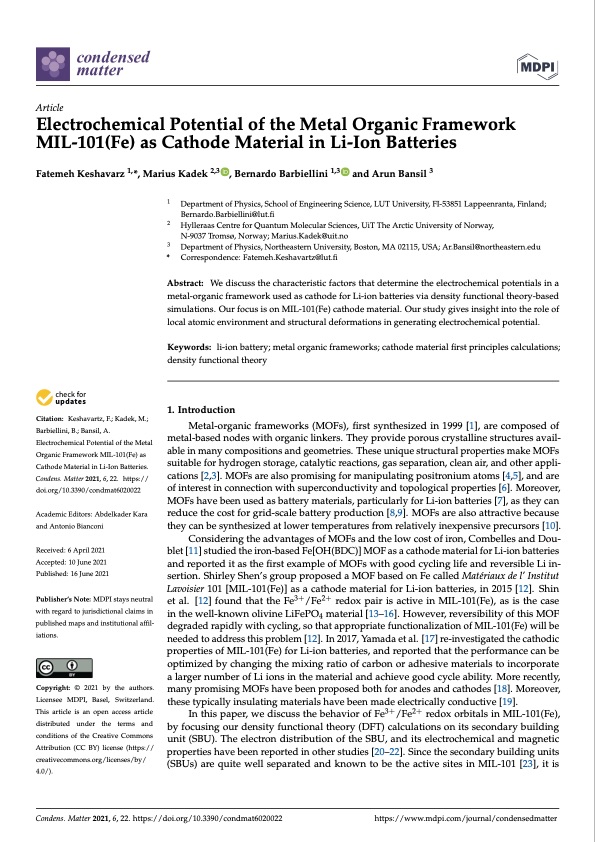
PDF Publication Title:
Text from PDF Page: 001
Article Electrochemical Potential of the Metal Organic Framework MIL-101(Fe) as Cathode Material in Li-Ion Batteries Fatemeh Keshavarz 1,*, Marius Kadek 2,3 , Bernardo Barbiellini 1,3 and Arun Bansil 3 1 2 3 Abstract: We discuss the characteristic factors that determine the electrochemical potentials in a metal-organic framework used as cathode for Li-ion batteries via density functional theory-based simulations. Our focus is on MIL-101(Fe) cathode material. Our study gives insight into the role of local atomic environment and structural deformations in generating electrochemical potential. Keywords: li-ionbattery;metalorganicframeworks;cathodematerialfirstprinciplescalculations; density functional theory 1. Introduction Metal-organic frameworks (MOFs), first synthesized in 1999 [1], are composed of metal-based nodes with organic linkers. They provide porous crystalline structures avail- able in many compositions and geometries. These unique structural properties make MOFs suitable for hydrogen storage, catalytic reactions, gas separation, clean air, and other appli- cations [2,3]. MOFs are also promising for manipulating positronium atoms [4,5], and are of interest in connection with superconductivity and topological properties [6]. Moreover, MOFs have been used as battery materials, particularly for Li-ion batteries [7], as they can reduce the cost for grid-scale battery production [8,9]. MOFs are also attractive because they can be synthesized at lower temperatures from relatively inexpensive precursors [10]. Considering the advantages of MOFs and the low cost of iron, Combelles and Dou- blet [11] studied the iron-based Fe[OH(BDC)] MOF as a cathode material for Li-ion batteries and reported it as the first example of MOFs with good cycling life and reversible Li in- sertion. Shirley Shen’s group proposed a MOF based on Fe called Matériaux de l’ Institut Lavoisier 101 [MIL-101(Fe)] as a cathode material for Li-ion batteries, in 2015 [12]. Shin et al. [12] found that the Fe3+/Fe2+ redox pair is active in MIL-101(Fe), as is the case in the well-known olivine LiFePO4 material [13–16]. However, reversibility of this MOF degraded rapidly with cycling, so that appropriate functionalization of MIL-101(Fe) will be needed to address this problem [12]. In 2017, Yamada et al. [17] re-investigated the cathodic properties of MIL-101(Fe) for Li-ion batteries, and reported that the performance can be optimized by changing the mixing ratio of carbon or adhesive materials to incorporate a larger number of Li ions in the material and achieve good cycle ability. More recently, many promising MOFs have been proposed both for anodes and cathodes [18]. Moreover, these typically insulating materials have been made electrically conductive [19]. In this paper, we discuss the behavior of Fe3+/Fe2+ redox orbitals in MIL-101(Fe), by focusing our density functional theory (DFT) calculations on its secondary building unit (SBU). The electron distribution of the SBU, and its electrochemical and magnetic properties have been reported in other studies [20–22]. Since the secondary building units (SBUs) are quite well separated and known to be the active sites in MIL-101 [23], it is Department of Physics, School of Engineering Science, LUT University, FI-53851 Lappeenranta, Finland; Bernardo.Barbiellini@lut.fi Hylleraas Centre for Quantum Molecular Sciences, UiT The Arctic University of Norway, N-9037 Tromsø, Norway; Marius.Kadek@uit.no Department of Physics, Northeastern University, Boston, MA 02115, USA; Ar.Bansil@northeastern.edu * Correspondence: Fatemeh.Keshavartz@lut.fi Citation: Keshavartz,F.;Kadek,M.; Barbiellini, B.; Bansil, A. Electrochemical Potential of the Metal Organic Framework MIL-101(Fe) as Cathode Material in Li-Ion Batteries. Condens.Matter2021,6,22. https:// doi.org/10.3390/condmat6020022 Academic Editors: Abdelkader Kara and Antonio Bianconi Received: 6 April 2021 Accepted: 10 June 2021 Published: 16 June 2021 Publisher’s Note: MDPI stays neutral with regard to jurisdictional claims in published maps and institutional affil- iations. Copyright: © 2021 by the authors. Licensee MDPI, Basel, Switzerland. This article is an open access article distributed under the terms and conditions of the Creative Commons Attribution (CC BY) license (https:// creativecommons.org/licenses/by/ 4.0/). Condens. Matter 2021, 6, 22. https://doi.org/10.3390/condmat6020022 https://www.mdpi.com/journal/condensedmatterPDF Image | Electrochemical Potential MIL-101(Fe) as Cathode Material in Li-Ion Batteries

PDF Search Title:
Electrochemical Potential MIL-101(Fe) as Cathode Material in Li-Ion BatteriesOriginal File Name Searched:
condensedmatter-06-00022.pdfDIY PDF Search: Google It | Yahoo | Bing
Sulfur Deposition on Carbon Nanofibers using Supercritical CO2 Sulfur Deposition on Carbon Nanofibers using Supercritical CO2. Gamma sulfur also known as mother of pearl sulfur and nacreous sulfur... More Info
CO2 Organic Rankine Cycle Experimenter Platform The supercritical CO2 phase change system is both a heat pump and organic rankine cycle which can be used for those purposes and as a supercritical extractor for advanced subcritical and supercritical extraction technology. Uses include producing nanoparticles, precious metal CO2 extraction, lithium battery recycling, and other applications... More Info
| CONTACT TEL: 608-238-6001 Email: greg@infinityturbine.com | RSS | AMP |